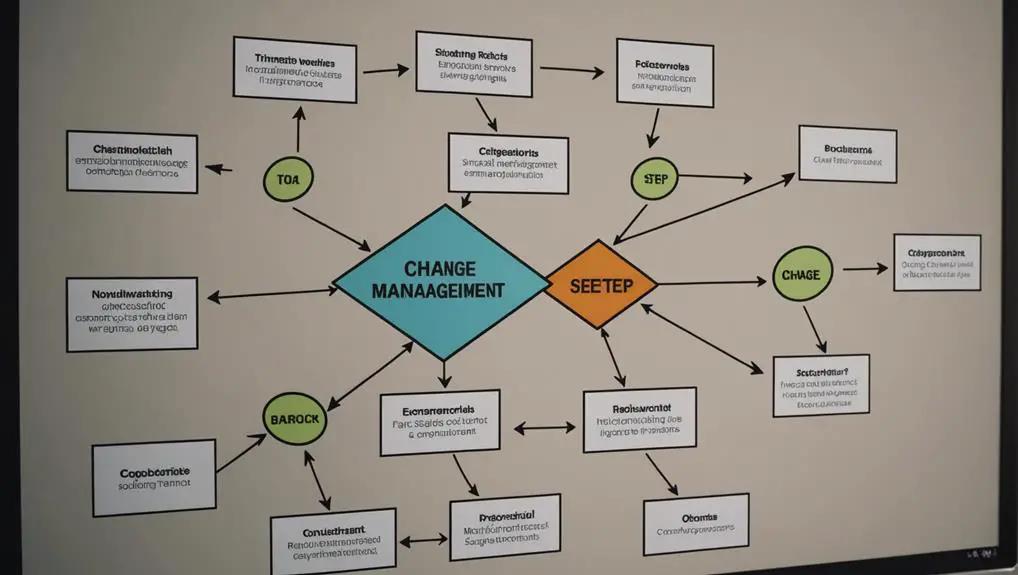As you navigate the intricate realm of change management, envision yourself as a skilled architect crafting a blueprint for transforming your organization. Each step you take is like adding a crucial piece to the puzzle of facilitating successful change.
When you can identify the important areas that require improvement and foster new ideas, you lay the groundwork for a seamless transition to a more adaptable and responsive organizational structure. So, prepare to uncover the key strategies and insights that will guide you on this transformative journey.
Key Takeaways
Let’s break it down into clear steps and assign responsibilities for the change process. We’ll establish communication channels to keep everyone informed and gather feedback. We’ll monitor progress, address challenges, and adjust as necessary. It’s essential to engage employees to ensure their commitment and the success of the initiative. We’ll evaluate the impact, enhance processes, and continuously refine strategies.
Identify Areas Requiring Change
If you aim to implement lasting changes, begin by pinpointing where your organization needs improvement. Engage everyone by soliciting their input through surveys, feedback sessions, and data analysis. This approach enables you to identify the areas in need of a makeover.
To determine which aspects of your organization are not meeting targets, examine key performance indicators. By identifying roadblocks, inefficiencies, or gaps that hinder progress, you can focus on changes that will have the most significant impact. Addressing these areas is crucial for making tangible progress in change management.
Brainstorm Implementation Ideas
To drive change effectively, you must generate new ideas and collaborate with others. Experiment with various methods to brainstorm ideas and consider different perspectives.
When you collaborate on implementing these ideas, you can devise effective solutions for managing change successfully. Techniques like brainstorming sessions, mind mapping, and SWOT analysis can help generate innovative ideas for driving change.
Collaborative Implementation Strategies
By assembling a diverse group to brainstorm how to implement new ideas, you can develop creative strategies for managing change together. Involving employees in the change process not only fosters a sense of ownership but also ensures their commitment to achieving business goals.
Listening to employees’ feedback and gaining their support helps identify crucial steps to ensure smooth change implementation. Collaborating on these changes is vital for enhancing organizational performance by leveraging everyone’s ideas and expertise.
Develop Change Management Workflow
Crafting a robust change management workflow is essential for guiding and optimizing the change process in your organization. When developing your change management workflow, consider the following:
Define Clear Steps and Responsibilities: Clearly outline the steps in the change process and assign specific responsibilities to individuals or teams.
Set Timelines and Identify Dependencies: Establish realistic timelines for each step of the change process and identify any interdependent tasks to facilitate smooth collaboration and prevent delays.
Establish Effective Communication Channels: Implement communication channels for providing updates, addressing concerns, and receiving feedback throughout the change process to encourage teamwork and keep everyone informed.
Implement Change Process
To ensure a smooth change process, follow through with planned strategies and actions that align with the organization’s goals and vision. Effectively implementing changes requires employees to understand their roles, responsibilities, and how the changes will impact their work. Monitoring progress, addressing challenges, and making necessary adjustments are critical for successful implementation. Engaging stakeholders, offering support, and measuring outcomes are essential components of a successful change management solution.
Monitor Success and Gather Feedback
To monitor the effectiveness of the change management solution, track key performance indicators and gather feedback. Monitoring progress against set goals and regularly checking KPIs ensures alignment with organizational objectives.
Gathering feedback from employees, stakeholders, and end-users provides valuable insights into the impact of changes and their effectiveness. Utilize surveys, focus groups, and feedback sessions to collect qualitative and quantitative data to improve the change management strategy based on received feedback.
Measure Impact and Optimize Processes
Monitoring productivity, efficiency, and employee satisfaction is crucial for assessing the impact of changes and identifying areas for improvement. Analyzing data and feedback from stakeholders helps prioritize areas for improvement and make informed decisions. Continuously refine strategies based on feedback and data to ensure changes align with organizational goals and drive positive outcomes.
Drive Positive Outcomes Through Changes
Successfully implementing changes requires a strategic approach focused on clear communication, employee involvement, and effective feedback systems. Engage employees by seeking their input and participation in the change process to foster ownership and dedication to the changes. Establish deadlines for implementing new processes, utilize feedback tools like surveys, and involve employees throughout the change management process to enhance collaboration and ensure successful organizational change.
Frequently Asked Questions
What Are the Steps in Implementing Change Management?
To implement changes smoothly, ensure readiness among all stakeholders, communicate effectively, address resistance, engage stakeholders, provide leadership, align company culture, and offer training and support.
What Is the 7 Steps of Change Management?
The 7 steps of change management include ensuring readiness, effective communication, addressing resistance, engaging stakeholders, confident leadership, aligning culture, and providing training and support.
What Are the 5 C’s of Change Management?
The 5 C’s of change management include communication strategies, resistance management, training programs, aligning culture, and leadership support.
What Are the 7 Steps in the Planned Change Model?
The 7 steps in the planned change model involve ensuring readiness, involving stakeholders, establishing a communication plan, managing resistance, providing training, gaining leadership support, involving employees, analyzing data, striving for continuous improvement, and fostering a strong organizational culture.
Conclusion
Congratulations on successfully implementing a change management solution! Organizations that excel in change management are 3.5 times more likely to outperform their competition. By adhering to a structured plan, monitoring progress, and adjusting processes as needed, you are poised to achieve remarkable results and stay ahead in the dynamic business landscape. Embrace change for continued success and innovation!



